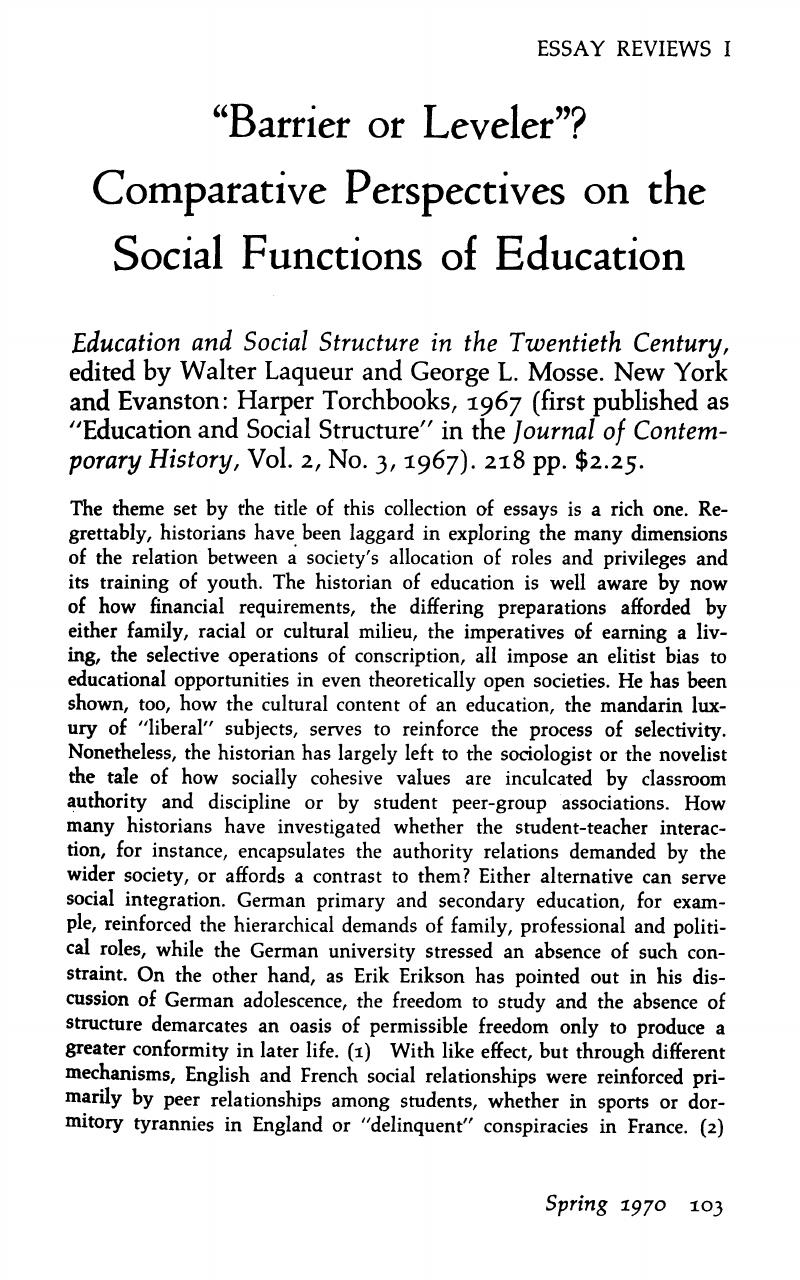No CrossRef data available.
Published online by Cambridge University Press: 24 February 2017

1. Erikson, Erik H., “The Legend of Hitler's Childhood,” Childhood and Society (New York: Norton and Co., 1963), esp. pp. 334–35.Google Scholar
2. For the English system as it has evolved: Wilkinson, Rupert H., The Prefects: British Leadership and the Public School Tradition (London: Oxford University Press, 1964); Weinberg, Ian, The English Public Schools: The Sociology of Elite Education (New York: Atherton Press, 1967); John Wakeford, The Cloistered Elite (London: Macmillan, 1969). For peer groups and education in France, see Jesse R. Pitts, “Continuity and Change in Bourgeois France,” in Stanley Hoffmann, Charles Kindleberger, et al., In Search of France (New York: Harper and Row, 1965), pp. 254-59; Lawrence Wylie, Village in the Vaucluse (New York: Harper and Row, 1964), pp. 55-97.Google Scholar
3. See especially the pieces by Jurgen Herbst, “High School and Youth in America,” pp. 165-82; Williiam J. McGrath, “Student Radicalism in Vienna,” pp. 183-201; Donald G. MacRae, “The Culture of a Generation: Students and Others,” pp. 3-13, emphasizes that cultural problems have superseded those of social stratification, but is oriented only toward an overview of the 1960's.Google Scholar
4. For the founding of Berlin, Max Lenz, Geschichte der Königlichen Friedrich-Wilhelms-Universität zu Berlin (4 vols.: Halle: Buchhandlung des Waisenhauses, 1910), I, Gründung und Ausbau; for the programs of Fichte, Humboldt, Schliermacher: Wilhelm Weichschedel, ed., Idee und Wirklichkeit einer Universität. Dokumente zur Geschichte der Friedrich-Wilhelms-Universität zu Berlin (Berlin: W. de Gruyter, 1960), pp. 28-203. Cf. also the locus classicus of the Bildungsideal: Wilhelm von Humboldt, Ideen zu einem Versuch die Grenzen der Wirksamkeit des Staates zu bestimmen [1792] (Stuttgart: Reclam, 1967), transl. J. Coulthard, The Spheres and Duties of Government (London: J. Chapman, 1854).Google Scholar
5. Ringer, Fritz K., “Higher Education in Germany in the Nineteenth Century,” pp. 123–38.Google Scholar
6. Ringer, Fritz K., The Decline of the German Mandarins: The German Academic Community, 1890-1933 (Cambridge, Mass.: Harvard University Press, 1969), esp. pp. 143–99, 227 ff., 305-434.Google Scholar
7. Krieger, Leonard, The German Idea of Freedom (Boston: Beacon Press, 1957); Lukács, Georg, Die Zerstörung der Vernunft (Neuwied am Rhein, Berlin-Spandau: Luchterhand, 1962).Google Scholar
8. Röhl, J. C. G., “Higher Civil Servants in Germany, 1890-1900,” pp. 101–21.Google Scholar
9. On this see Schlink, Wilhelm, “Wesen und Gestaltung der technischen Hochschulen,” in Doeberl, Michael, Scheel, Otto, et al., Das akademische Deutschland, Vol. III: Die deutschen Hochschulen in ihren Beziehungen zur Gegenwartskultur (Berlin: C. A. Weller, 1930). For the businessman's increasingly academic background by 1930, cf. Wilhelm Treue, “Der deutsche Unternehmer in der Weltwirtschaftskrise, 1928-1933,” in Werner Conze and Hans Raupach, eds., Die Staatsund Wirtschaftskrise des deutschen Reichs 1929/33 (Stuttgart: Ernst Klett Verlag, 1967), p. 91.Google Scholar
10. Dahrendorf, Ralf K., “The Crisis in German Education,” pp. 139–47. Cf. also Dahrendorf, Society and Democracy in Germany (Garden City, N.Y.: Doubleday and Co., 1967), pp. 312-29 on education, and 249-79 on elites.Google Scholar
11. Ward, David, “The Public Schools and Industry in Britain after 1870” pp. 37–52, quote p. 52. For the interplay of British education and society in the nineteenth century, see G. Kitson Clark, The Making of Victorian England (Cambridge, Mass.: Harvard University Press, 1962), pp. 255-74; cf. also Sheldon Rothblatt, The Revolution of the Dons: Cambridge and Society in Victorian England (London: Basic Books, 1968).Google Scholar
12. Barnett, Correlli, “The Education of Military Elites,” pp. 15–35.Google Scholar
13. Ibid., pp. 21-25.Google Scholar
14. Bourdieu, Pierre and Claude Passeron, Jean, Les Héritiers; les étudiants et la culture (Paris: Éditions de Minuit, 1964); Goblot, Edmond, La Barrière et le niveau. Étude sociologique sur la bourgeoisie française moderne [1925] (Paris: Presses Universitaires de France, 1967); and for a general survey of family determinants behind the students of France's elite schools: Alain Girard, La réussite sociale en France (Paris: Presses Universitaires de France, 1961). For an interwar discussion with similar concerns that illuminates Italy and Germany see Robert Michels, Umschichtungen in den herrschenden Klassen nach dem Kriege (Stuttgart-Berlin: D. Kohlhammer, 1934), pp. 58-85.Google Scholar
15. Mitchell, Allan, “German History in France after 1870” pp. 81–100.Google Scholar
16. Zeldin, Theodore, “Higher Education in France, 1848-1940,” pp. 53–80, esp. pp. 74-75, on the question of technical education in France.Google Scholar
17. Crozier, Michel, The Bureaucratic Phenomenon (Chicago: University of Chicago Press, 1967), esp. pp. 195–98, 238-44.Google Scholar
18. Karier, Clarence J., “Elite Views on American Education,” pp. 149–63.Google Scholar
19. McGrath, , “Student Radicalism in Vienna,” pp. 183–201.Google Scholar
20. Vázquez de Knauth, Josefina, “Mexico: Education and National Integration,” pp. 202–14.Google Scholar
21. Mosse, George L., “Concluding Remarks,” pp. 215–18.Google Scholar
22. Herbst, , “High School and Youth in America,” pp. 166–79.Google Scholar
23. For new methods in this regard as applied to current educational investment and return see Samuel Bowles, Planning Educational Systems for Economic Growth (Cambridge, Mass.: Harvard University Press, 1969).Google Scholar